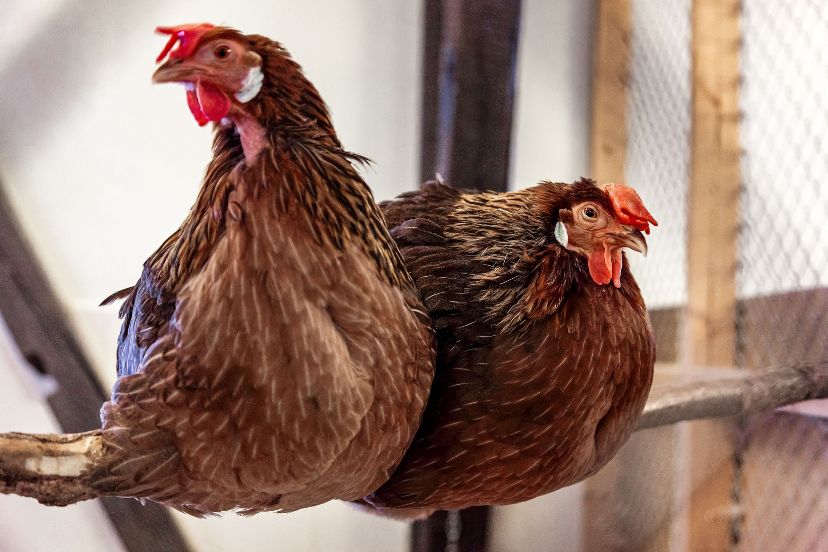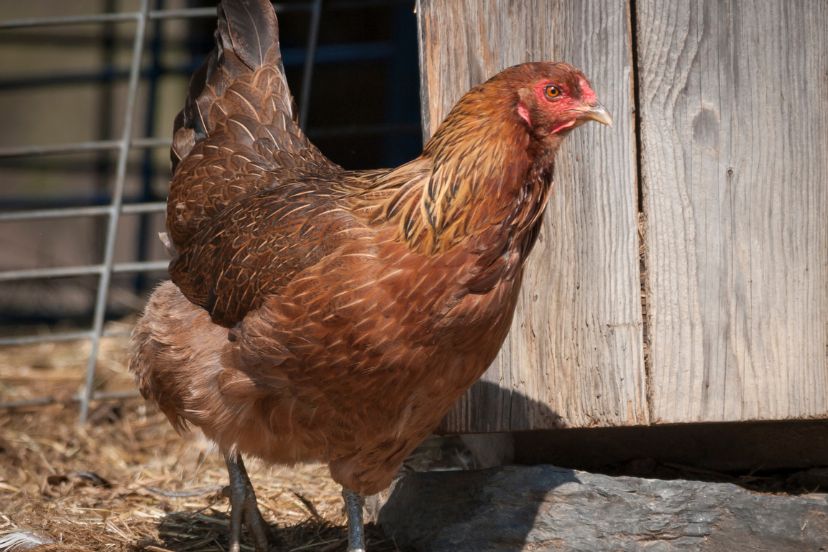Brown Leghorn Chickens: Production, Broodiness & Behavior
The story of Brown Leghorn Chickens begins in the coastal regions of Italy, where their charm and robustness first caught the eyes of poultry lovers. Over time, they made their way to other parts of the world, endearing themselves to farmers and enthusiasts alike. The unique combination of their physical attributes, egg-laying abilities, and spirited personalities have made them a standout choice for both commercial and backyard poultry farming.
| Read Next: |
10 Small Chicken Breeds for Beginners
Physical Characteristics
Appearance
Upon encountering Brown Leghorn Chickens for the first time, one is often immediately struck by its poised stance and energetic demeanor. These chickens have an elegance to them, distinguished by their slender, athletic build that speaks to their active nature. Their eyes, always gleaming with a touch of mischief and curiosity, convey a sense of alertness, making it clear they’re always ready for action. Whether they’re scavenging for food or simply roaming about, their every move is a testament to their vitality.
Size and color
While many chicken breeds can be quite varied in size, Brown Leghorn Chickens maintain a consistent medium stature. They’re neither too large to handle nor too small to be noticed. But what truly sets them apart is their vibrant feather palette. Cloaked in a rich tapestry of reddish-brown hues juxtaposed against deeper black feathers, these birds are a visual treat. This combination not only offers them a camouflage advantage in natural settings but also adds to their visual appeal in domesticated environments.
Yet, when we talk about distinctive features, it’s impossible not to mention their combs and wattles. The comb, often brilliantly red and upright, complements the hanging wattles below their beak. These features aren’t just ornamental; they serve a functional purpose, aiding in thermoregulation. However, it’s hard to deny that their sleek combs and wattles contribute significantly to the Brown Leghorn’s iconic appearance.
Egg-laying capabilities
Now, if you’re considering keeping chickens primarily for their egg-laying abilities, Brown Leghorn Chickens are undeniably one of the top contenders. It’s not an exaggeration to call them the superstars of the poultry world in this respect. Their reputation as prolific layers is well-deserved, with many owners pleasantly surprised by the consistent supply of eggs.
But it’s not just about quantity with Brown Leghorn Chickens; it’s about the quality and consistency, too. Their eggs, characterized by a pristine white shell, are a staple in many households. The frequency? Well, brace yourself because these feathery dynamos are known to produce an egg nearly every day, ensuring that you have a steady supply for your morning breakfast or baking needs. While the average chicken breed might lay 3-4 eggs a week, Brown Leghorns often outperform them, making them a favorite among those looking for reliable egg production.
Why Choose Brown Leghorn Chickens?
Navigating the world of poultry can be overwhelming with so many breeds to choose from. So, why should Brown Leghorns make it to the top of your list? Let’s dive in!

High egg production
When it comes to rearing chickens, one of the primary motivations for many enthusiasts and farmers is egg production. And in this domain, the Brown Leghorns are undisputed champions. The simple arithmetic behind poultry farming is often about numbers – more hens typically lead to a larger quantity of eggs. But with Brown Leghorn Chickens, there’s a twist. Even a smaller flock of these birds can yield a surprisingly large number of eggs, given their prolific laying tendencies. This means that, on average, you’ll have a continuous supply, ensuring that your egg basket is always brimming. So, whether you’re considering selling eggs or simply ensuring a steady supply for home use, Brown Leghorns are a wise investment.
Hardy and resilient
Venturing into poultry farming or even backyard chicken keeping means being ready for challenges. Illnesses, changing weather conditions, and predators can be daunting. However, with Brown Leghorns, you have a slightly easier journey ahead. These birds have evolved and adapted to be hardy and resilient. They boast a robust immune system, making them less susceptible to common poultry diseases. This resilience isn’t just about their health; it’s also about their adaptability. Whether it’s scorching summers or chilly winters, Brown Leghorns manage to thrive with minimal fuss. Think of them as the sturdy, reliable friends who’re always there, rain or shine.
Low maintenance
If the idea of having pets or farm animals sounds appealing, but you’re wary of high-maintenance creatures that demand constant attention, Brown Leghorn Chickens are your answer. These birds are remarkably self-sufficient. While they, of course, require the basics like food, water, and shelter, they’re not the type to throw a fuss if things aren’t perfect. They’re adept at foraging, often finding a significant portion of their diet in the yard. They don’t constantly seek human interaction, making them perfect for those who can’t always dedicate hours to their flock. However, this independence doesn’t mean they’re aloof. Give them their space, meet their basic needs, and they’ll reward you with consistent egg production and relatively drama-free companionship. It’s the ideal balance for anyone seeking the joys of poultry without the overwhelming demands.
Caring for Brown Leghorns
While Brown Leghorn Chickens are relatively low-maintenance, they still require specific care to ensure their well-being and optimize their egg-laying capabilities. Here’s a more in-depth look into the care guidelines for these feathered dynamos.

Feeding Guidelines
Caring for any living creature begins with ensuring they receive adequate nutrition. For chickens, especially prolific layers like the Brown Leghorns, a well-balanced diet is critical.
General Diet: A quality commercial chicken feed should be the staple of their diet, ensuring they receive all the necessary nutrients. However, diversifying their diet can benefit their health and egg production. Grains like corn, barley, or wheat can be a fantastic supplement. Seeds, such as sunflower seeds or flaxseeds, provide essential fats. And don’t forget about vegetables! Greens like lettuce, spinach, and kale or even carrot scraps can add variety and essential vitamins to their diet. Remember, while treats and supplements are great, they should not make up more than 10% of their overall diet.
Check out these Certified Organic Non-GMO Chicken Feed Options formulated with protein from organic whole grains, sustainable grub protein, essential oils, vitamins, and minerals. Promotes strong muscles, healthy bones, and vibrant feathers for your flock.
Diet Specifics
Given the exceptional egg-laying prowess of Brown Leghorn Chickens, their diet needs a bit more attention to specific nutrients.
Protein: High-quality protein is essential for maintaining the health and vigor of Brown Leghorns. Consider feeds that contain around 16-18% protein. Sources like mealworms, fish meal, or even occasional servings of scrambled eggs can be great protein boosters.
Calcium: Eggshells are primarily composed of calcium. To ensure the shells are strong and the hens remain healthy, calcium supplementation is crucial. While commercial layer feed will often have added calcium, oyster shells or crushed eggshells can be provided as an additional source. Ensure these are available in a separate dish so hens can consume as per their requirement.
Shelter and Protection
Regardless of their hardiness, Brown Leghorns, like all chickens, need protection from potential threats.
The Coop
Every chicken requires a safe, dry place to roost at night. For Brown Leghorn Chickens, a well-ventilated coop that shields them from the elements is essential. Make sure it’s spacious enough to accommodate your flock comfortably, with at least 2-3 square feet per bird inside the coop. Elevated roosting bars and nesting boxes filled with soft bedding (like straw or wood shavings) will make their resting time pleasant.
Read our article Comprehensive Guide to Building Chicken Coops for more information.
Safety Measures
Predators, be it foxes, raccoons, or even birds of prey, can be a significant threat to free-ranging chickens. To safeguard your flock, the coop should be fortified with predator-proof latches. If your Brown Leghorns have an outdoor run or free-range, consider covering the area with netting or poultry wire to protect from aerial threats.
Environmental Protection
Brown Leghorns are adaptable, but extreme weather conditions can still affect them. During the heat, ensure they have access to shade and fresh water. In colder climates, while they can handle the cold reasonably well, ensure the coop is draft-free and retains warmth. Heating elements can be added if temperatures drop too low.
In conclusion, while Brown Leghorns are independent and resilient, they flourish best with a balanced diet and a safe, comfortable environment. Proper care not only guarantees their well-being but also ensures a consistent bounty of fresh eggs for your table.
Common Myths Debunked
Like many other breeds, Brown Leghorns come with their share of myths and misconceptions. Let’s set the record straight on a few of these.
Aggressiveness
The chicken community often buzzes with whispers and stories about certain breeds being inherently aggressive. Brown Leghorns, unfortunately, have been painted with this brush too. But let me clear the air: it’s simply not true.
The Reality
Yes, Brown Leghorns can be a tad more active and flighty than some of the more docile breeds. Their energetic demeanor often gets misconstrued as aggressive behavior. However, in reality, this “flightiness” is more about them being alert and curious, rather than being mean-spirited or hostile. They like their space and might not be as cuddly as some other breeds, but that’s a far cry from being aggressive. If handled regularly from a young age and socialized well, they can be just as friendly and approachable as any other chicken. It’s all about understanding and respecting their spirited nature!
Egg Color Misconceptions
This one’s a classic misconception that often baffles newcomers to the world of Brown Leghorns. Given their name and feather color, it’s a natural assumption that they’d lay brown eggs.
The Reality
Color me surprised! Despite their moniker, Brown Leghorns lay pristine, glossy white eggs. The egg color of chickens is typically linked to earlobe color, not feather color. In the case of Brown Leghorns, they have white earlobes, which is a giveaway for their white egg-laying capability. It’s an amusing twist of nature that often takes folks aback. So, the next time someone assumes that a chicken’s feather color determines its egg color, you’ll have a fun fact to share!
In the grand tapestry of chicken folklore, myths are inevitable. However, with knowledge, observation, and firsthand experience, we can debunk these misconceptions and appreciate our feathered friends for who they truly are. So, the next time you hear a tall tale about Brown Leghorns, you’ll be well-equipped to share the real story.
FAQs
How long do Brown Leghorns live? On average, they live for about 5-7 years, provided they’re well taken care of.
Do they do well with other breeds? Yes! With proper introductions, they can coexist peacefully with other breeds.
Are Brown Leghorns noisy? They have their moments, especially during the laying period, but they’re not consistently noisy.
How early do they start laying? Typically around 4-5 months, earlier than some other breeds.
Is it challenging to differentiate between males and females when they’re chicks? It can be initially, but as they grow, physical differences like comb size become more apparent.




